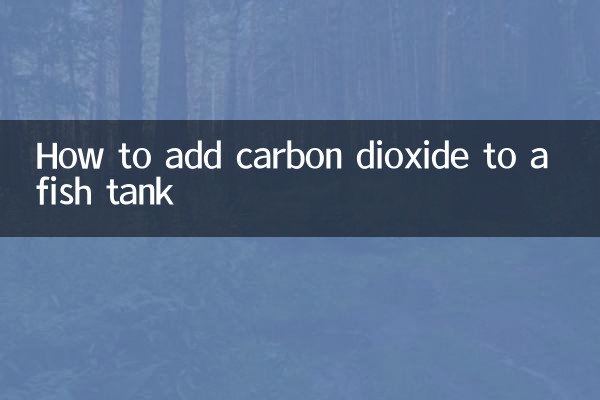Title: How to add carbon dioxide to a fish tank
In the process of fish farming, the addition of carbon dioxide is crucial for the growth of aquatic plants and the stability of water quality. This article will introduce in detail how to add carbon dioxide to a fish tank, including equipment selection, operating steps and precautions, to help you master this technique easily.
1. Why do you need to add carbon dioxide to the fish tank?

Carbon dioxide is an important raw material for photosynthesis of aquatic plants. Appropriate addition of carbon dioxide can promote the growth of aquatic plants, improve water quality, and inhibit the growth of algae. The following are the main effects of carbon dioxide on fish tank ecology:
| effect | illustrate |
|---|---|
| Promote the growth of aquatic plants | Aquatic plants absorb carbon dioxide and release oxygen through photosynthesis to promote healthy growth. |
| Stable water quality | Carbon dioxide can adjust the pH value of water and prevent excessive fluctuations in water quality. |
| Inhibit algae | Healthy aquatic plants can compete with algae for nutrients and reduce algae growth. |
2. Common methods of adding carbon dioxide to fish tanks
Common carbon dioxide addition methods currently on the market mainly include the following:
| method | Features | Suitable for the crowd |
|---|---|---|
| Cylinder carbon dioxide system | Stable, efficient and suitable for long-term use, but the cost is high. | Professional aquarium player |
| DIY yeast fermentation method | The cost is low, but the stability is poor and raw materials need to be replaced frequently. | Newbies on a budget |
| carbon dioxide tablets | Easy to use, but the effect is limited, suitable for small fish tanks. | Small fish tank enthusiasts |
3. Installation and use steps of cylinder carbon dioxide system
Cylinder carbon dioxide system is currently the most commonly used method. The following are detailed installation and usage steps:
| step | Operating Instructions |
|---|---|
| 1. Prepare equipment | Purchase carbon dioxide cylinders, pressure reducing valves, refiners, bubble counters and other equipment. |
| 2. Install pressure reducing valve | Connect the pressure reducing valve to the cylinder and ensure a good seal. |
| 3. Connect the bubble counter | Connect the bubble counter through a hose to observe the flow of carbon dioxide. |
| 4. Install refiner | Place the refiner into the fish tank to ensure that the carbon dioxide is evenly dissolved. |
| 5. Adjust flow |
When adjusting the flow rate, it is recommended to initially set it to 1-2 bubbles per second and gradually adjust it according to the response of the aquatic plants. The recommended opening time is 6-8 hours a day, synchronized with the light.
4. Precautions
When adding carbon dioxide to the fish tank, you need to pay attention to the following points:
| Things to note | illustrate |
|---|---|
| avoid overdose | Excess carbon dioxide can cause fish to become hypoxic and even die. |
| Monitor pH | Check the pH value of the water regularly to ensure it is between 6.5-7.5. |
| Closed at night | Aquatic plants do not perform photosynthesis at night and need to shut down the supply of carbon dioxide. |
5. Frequently Asked Questions
Here are frequently asked questions about adding carbon dioxide to fish tanks:
| question | answer |
|---|---|
| Aquatic plants don’t react after carbon dioxide is added? | It may be insufficient light or lack of nutrients. Check the light and fertilizer. |
| If there are fish in the fish tank, can carbon dioxide be added? | Yes, but the flow needs to be controlled to prevent fish from being deprived of oxygen. |
| How often do carbon dioxide cylinders need to be replaced? | Depending on the frequency of use, it is usually replaced once every 1-2 months. |
Conclusion
Adding carbon dioxide to the fish tank is an effective way to improve the growth of aquatic plants and stabilize water quality. You can easily achieve this by choosing the right equipment, installing it correctly, and regulating flow. I hope this article can help you better manage the fish tank ecology and enjoy the fun of fish farming!

check the details

check the details